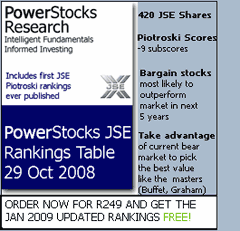PowerStocks put this to the test on the JSE, ranking the 5 year average growth of stocks together with their Piotroski "F" scores as at 28 April 2003 (trough of the last big bear market). We performed the tests with all JSE shares listed at that time and then only on those shares with Price:Book ratios of less than 1. The results are shown below:

The results are rather remarkable, confirming Piotroskis' theory for the JSE. Note how Piotroski is a great bear market screen for ANY stocks (shown by the blue bars) but worked especially well for "undervalued" stocks (shown by the red bars) when F>6. Note how portfolios of shares selected with F>6 significantly outperformed the ALSI and the group average growths.
Note how the average growth of the group P2Bk<=1 is much larger than the average growth of the entire group (All), confirming the theory we postulated that undervalued share portfolios are much more likely to outperform coming out of bear markets than other stocks (See Price-to-Book : An all-time classic)
We can state that historically, Piotroski "F" scores greater than or equal to 7 for "undervalued" shares showed significant out-performance to the group average (of undervalued stocks) and the all-share index (ALSI). It also showed a lesser but still significant out-performance for all stocks regardless of their price:book ratios.
The most important observation we can make here is that even though Price:Book has been shown to be a stong, safe selection criteria for potential growth stocks, Price:Book coupled with the Piotroski valuation significantly enhances portfolio performance. The almost 1,200% performance of the portfolio of "undervalued" shares with F greater than or equal to eight is double the group average of undervalued stocks (588%) and triple the growth of the market-cap based ALSI index (350%).
NEW : The Piotroski screen is our top performing portfolio we track on the JSE since 20 Nov 2008. You can view its performance coming out of the 2008 JSE crash over here.
NEXT : Piotroski JSE Candidates

















